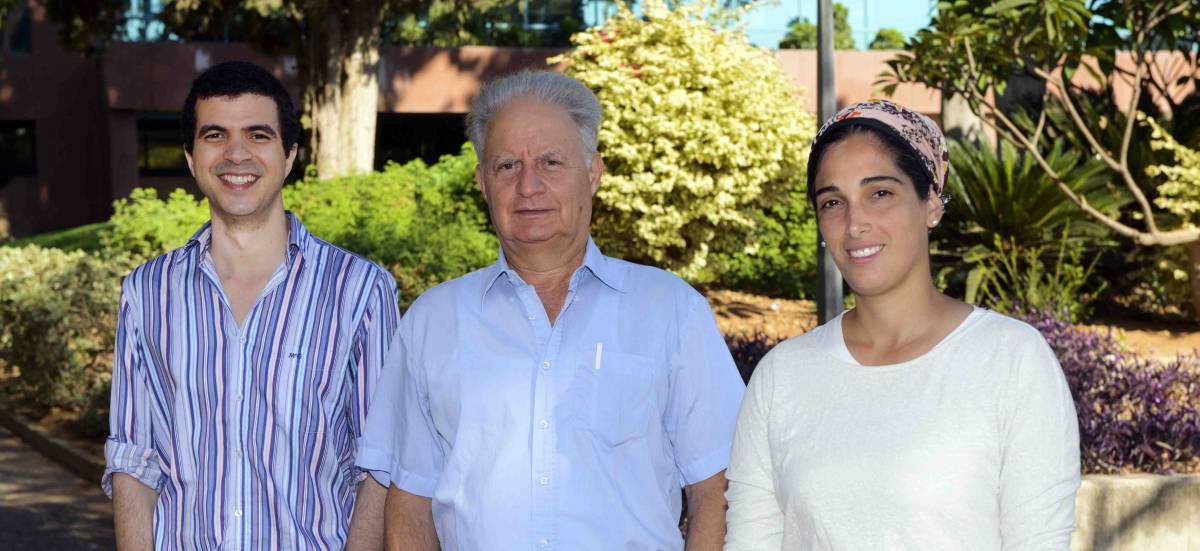Are you a journalist? Please sign up here for our press releases
Subscribe to our monthly newsletter:
Holograms – 3-D images – are widely used these days in entertainment and as anti-counterfeiting devices on everything from credit cards and bills to toothpaste packaging. A new type of hologram produced in Weizmann Institute of Science labs would be nearly impossible to counterfeit, and could be almost undetectable: It is made up of nanoparticles and can be seen only when invisible infrared light is shone onto the tiny chip in which the nanoparticles are arrayed in layers. The nanoparticles change the wavelength – using infrared light as input and generating blue light images – and they reconstruct a 3-D image through the careful design and placement of each nanoparticle in the array.
The nanoparticle holograms were produced by Prof. Yehiam Prior and postdoctoral fellow Dr. Euclides Almeida of the Institute’s Chemical Physics Department, and Dr. Ora Bitton of Chemical Research Support. This advance was recently reported in Nature Communications.

Our eyes, explains Prior, create a 3-D image of the world based on information we get from the light waves bouncing off objects. These include the amplitude, or intensity, of the light wave, and its phase – the “timing” of the waves’ cycles. “The phase is shifted in objects that are farther away; a standard (2-D) photograph captures the amplitude but not the phase of the light waves, leaving out crucial information on depth. To create a hologram, one must generally use film and two light sources – one of them a reference beam that is used to reconstruct the ‘third dimension’ of the image. The holograms can be computer-generated, but both methods restore phase information to the image, thus making it appear to our eyes in three dimensions. ”
Prior and his group realized that the nanoparticles they design and produce in the lab could be used to store holograms. “We didn’t change the basic principles of the hologram so much as throw out the film,” he says. “We can now control the properties of nanoparticles with a very high degree of precision and accuracy, and we can design them for any purpose, including storing photographic information.”
The new nanoparticles, made of metallic gold, are produced using the knowledge that has been acquired in a field known as plasmonics – the ability to manipulate light with nanotechnology. Plasmonics is based on several discoveries of the last few decades. One is that a metallic nanoparticle irradiated with a particular wavelength of light will have its electric field enhanced by many orders of magnitude. If a molecule is placed near the particle, the interaction between the light and the molecule can be a million times stronger than usual.
You must shine an ‘invisible’ light of a specific wavelength on them to get the visible image
A second discovery in plasmonics, from around 20 years ago, concerns holes – tiny apertures much smaller than the wavelength of light, so light can barely pass through. Surprisingly enough, it was found that for metallic films, light appears to be emitted from the hole’s other side, and the transmission is directly connected to the shape and size of the hole. The explanation for this phenomenon is that electrons, which are smaller than the hole and thus pass through freely, become excited and mediate the transmission of light through the hole.
With plasmonic design, the team found they could literally manipulate light. In addition to controlling the phase and amplitude so as to produce the 3-D effect of a hologram, the nanoparticles have the ability change a color to another one by adding together photons in the lower-energy, infrared range and emitting new photons with exactly three times the energy and one-third the wavelength – in this case, blue light.

The nanoparticles were produced in the Chemical Research Support’s clean room, their tiny shapes precisely engraved with electron beams; and these were encased in multiple dense layers between glass and silica. The resulting device could even store more than one image: In one example viewed under a microscope, depending on the polarization of the beam, one could observe a hologram of the first letter of the Hebrew alphabet, “Aleph,” or else, with a beam applied at a 90-degree angle, the letter “Shin.”
“The holograms are unique in that you must shine an ‘invisible’ light of a specific wavelength on them to get the visible image,” says Almeida. “This could provide extra layers of security. But there are many other applications for the technology we created, which combines accurate phase control with plasmonic nanoparticles in multiple layers.”
“We have learned to understand the coupling between the shape of the nanoparticle and its optical properties, and thus to control those properties,” says Prior. “This might lead, for example, to lenses that can focus differently in response to different light, the development of very high-resolution holograms, or dense optical information storage.”
Prof. Yehiam Prior's research is supported by the Mary and Tom Beck-Canadian Center for Alternative Energy Research; the Leona M. and Harry B. Helmsley Charitable Trust; and Dana and Yossie Hollander, Israel. Prof. Prior is the incumbent of the Sherman Professorial Chair of Physical Chemistry.